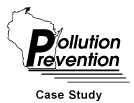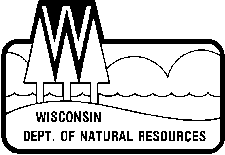
|
Quad/Graphics, Inc.
Solvent Recovery System for Ink Jet
Printing Operations |
| Standard Industrial
Classification (SIC) |
Commercial Printing/2752,2754 |
| Type of Waste |
Methyl Ethyl Keytone (MEK) -
Volatile Organic Compound (VOC) air emissions |
| Strategy |
Recover, condense, and reuse
VOC based solvent vapors with a Solvent Recovery System (SRS) |
| Company Background |
Quad/Graphics, Inc. is a
Pewaukee based, privately owned printer, founded in 1971. The company produces magazines,
catalogs, Sunday inserts, and direct mailings. Quad employs over 8,500 workers nationally
of which 6,800 are located in Wisconsin. In 1991, the company received a Governor’s
Award for Excellence in Hazardous Waste Reduction and in 1993 a Governor’s Waste
Reduction and Recycling Award. Quad/Graphics also is listed as one of the top 100
companies to work for in America. |
| Original Process |
Ink jetting is used to print
addresses, codes, and messages on magazines and catalogs. This process generates ambient
MEK vapors from the highly volatile ink used to ensure a short dry time. The ink jet
printing engines employ a print head which has a droplet generator from which multiple
continuous streams of ink are emitted under pressure. The droplets of ink are charged and
deflected by an electric field into a gutter for ink collection or onto paper or other
medium. The ink in the gutter is drawn by a vacuum pump back into the ink supply tank
where it is entrained in air vented from the ink supply tank. |
| Motivation |
Quad/Graphics recognized that
vapor lost as a fugitive emission could be recovered using a cooler/condenser process.
Quad/Tech, a subsidiary of Quad/Graphics that manufactures press and bindery control
equipment for the printing industry, has further advanced the technology. The motivating
factors for the project were to achieve environmental benefits and economic and energy
savings |
| Pollution Prevention
Process |
The Solvent Recovery System
(SRS) collects fugitive MEK process vapors (otherwise lost to the environment) and cools
them in a condensing unit. The unit recycles the vapors to a liquid that is recirculated
and reused in the ink jetting process. |
| Stage of Development |
The system is currently in the
prototype phase and is being tested in six Quad/Graphics printing plants. Quad/Graphics
plans to fully implement the process on all of its binding lines and partner with other
printers for beta testing sites. The company plans to eventually make the system available
for sale to other printers and industries. |
| Material/Energy
Balance |
Original Process
Feedstock
98,000 pounds per year of MEK fluids (inks and solvents) used in ink jet printing.Waste
VOC air emissions from MEK fluids. 56,000 #2 grade plastic containers difficult to recycle
due to ink residue.
Disposal
Plastic containers taken to landfill.
Energy
The transportation and manufacture of inks used in the printing process required the use
of 2.867 x 1010 BTUs at a cost of $335,869/per year.
Pollution Prevention Process
Feedstock
MEK-based fluids (inks and solvents) reduced by ~50%.
Waste
The SRS system recovers and reuses 80-90 percent of VOC vapors. Using the SRS system
on all binding lines will result in a minimum reduction of 49,000 pounds of toxic air
pollutants. This process also eliminates 28,000 #2 grade plastic containers that would
require handling and disposal.
Disposal
Plastic containers taken to landfill.
Energy
Quad will save 2.867 x 1010 BTUs of energy and ~ 335,869 each year from the
greatly reduced need to manufacture and transport ink. |
| Economics |
Capital Costs
The capital cost of an SRS unit is approximately $8,000. One unit is needed for each ink
jet print engine. Quad uses over 200 of these engines.Operation/Maintenance
Costs
Expenditures for ink and solvents are reduced by 50 percent. This will result in a
minimum savings of $552,000 per year. In addition, downtime on binding lines also is
decreased. The resulting savings are $3 million from increased productivity and $1.2
million from reduced labor costs.
Payback Period
The payback period is less than three months. |
| Benefits |
Benefits include: a 50 percent
reduction of MEK-based ink and solvent; use, recovery and reuse of 80-90 percent of
VOC vapors; reduction of down-time on binding lines; increase in productivity; reduction
in the amount of plastic containers to be handled and disposed of; possible avoidance of
add-on control equipment and air permits, therefore, saving on energy, end-of-pipe control
equipment costs, and administrative costs resulting from greater regulation of hazardous
air pollutants. |
| Obstacles |
Obstacles encountered were: the
cost of research, development, testing, and marketing; commercialization of a new
technology; and worker skepticism and unfamiliarity with the new equipment. Quad received
a cost-sharing grant from the National Industrial Competitiveness through Energy,
Environment, and Economics (NICE3) Program to help offset these costs. |
| Technology Transfer |
This technology can easily be
transferred to other printers through the marketing and commercialization efforts of
Quad/Tech. Applicable changes would be needed to modify the SRS units to work compatibly
with ink-jet print systems from different manufacturers and (or) using poly-alcohol based
ink and solvent. |
| Other Pollution
Prevention Activities |
The company has implemented a
wide variety of additional pollution prevention efforts. Examples of these include:
- Inks produced by the ink manufacturing division, and used by the
pressrooms, are enviro-friendly inks. These inks use combinations of corn, linseed, and
soybean oil. These renewable oil resources, in part, replace petroleum-based oils. The
resulting formulations meet and exceed the minimum requirements set by the American
Soybean Association. Secondly, the formation of VOCs is reduced by increasing the amount
of solids used in the ink and using a greater percentage of renewable resources.
- In prepress operations, a filmless printing plate is used, to avoid the
production of film and use of chemicals in the process.
- Ink waste has been reduced by 40 percent; from 762 to 460 drums
between 1989-1994. (Note that figures represent absolute, not relative reductions.
Production increased 111% during the same period.)
- The pallet repair department remanufactures broken pallets and makes
mulch out of those that are beyond repair. In 1994, this department repaired over 96,000
pallets and produced over 600 tons of landscape mulch.
- The pressrooms use reusable oil mats for leaking presses. In order to
reuse the mats, each press crew wrings out their mats with a wringing machine. The oil is
recycled and the mats are reused. This system has reduced oil mat consumption by 85% and
saves the company in excess of $47,000 per year.
|
| Company Address |
Quad/Graphics, Inc.
W224 N3322 Duplainville Road
Pewaukee, Wisconsin 53072 |
| Contact Person |
John R. Imes, Environmental
Manager
414/246-2080 |
| Pollution Prevention
Resources |
Free, On-site Technical
Assistance
University of Wisconsin Extension
Solid and Hazardous Waste Education Center
Milwaukee area: 414/475-2845
Remainder of state: 608/262-0385Pollution Prevention
Information Clearinghouse
Wisconsin Department of Natural Resources
Hazardous Waste Minimization Program
608/264-8852, 608/267-9523 or 608/267-3763 |
 |
Bureau of Cooperative Environmental Assistance
Wisconsin Department of Natural Resources
P.O. Box 7921
Madison, WI 53707
608/267-9700
PUBL-TS-054 96 |
|

